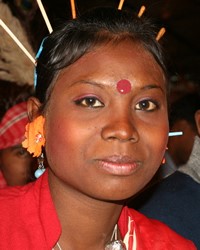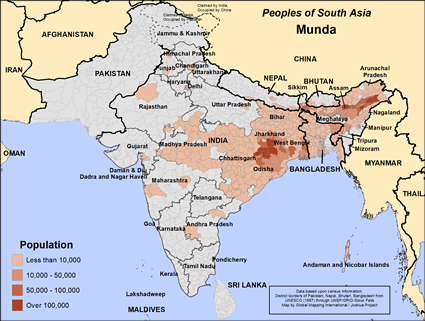Munda in India

Photo Source:
Ramesh Lalwani - Flickr
Creative Commons
|

Map Source:
People Group data: Omid. Map geography: UNESCO / GMI. Map Design: Joshua Project.
|
| People Name: | Munda |
| Country: | India |
| 10/40 Window: | Yes |
| Population: | 3,668,000 |
| World Population: | 3,726,000 |
| Primary Language: | Mundari |
| Primary Religion: | Hinduism |
| Christian Adherents: | 20.60 % |
| Evangelicals: | 10.30 % |
| Scripture: | Complete Bible |
| Ministry Resources: | Yes |
| Jesus Film: | Yes |
| Audio Recordings: | Yes |
| People Cluster: | South Asia Tribal - other |
| Affinity Bloc: | South Asian Peoples |
| Progress Level: |
|
Introduction / History
The Munda probably came to India from South East Asia hundreds of years ago. Most Munda live across northeast and central India. Most Indian Hindus see the Munda as outside the caste system. The Munda are one of the largest tribal people groups of India. They are one of the Scheduled Classes, which means the Munda are guaranteed places in education and government jobs. The Munda speak many different regional languages including their own language of Mundari, Assamese and Hindi. During the colonial period much of their land was taken away and they became agricultural workers tied to the land.
Where Are they Located?
The Munda live primarily in the northeast Indian states of Assam, Jharkand, Odisha and West Bengal.
What Are Their Lives Like?
The Munda have traditionally been farm laborers, woodcutters and basket weavers. They live in their own villages although some educated Munda have moved to the cities. They are endogamous, that is, they marry within their community. Society is patriarchal with older men ruling over the villages. A newly married couple lives with or near the husband's parents. Sons inherit land, houses and possessions. The main occupation of the Munda men and women is agriculture with most working fields owned by others. Their main food is rice along with fruits and vegetables. The Munda have elaborate rituals to celebrate birth, death, engagement and marriage according to the Wikipedia article on the Munda.
What Are Their Beliefs?
The Munda practice a religion called Sarnaism, the religion of the holy woods or Sal trees. Followers of Sarnaism worship the Creator God, Dharmesh or Singbonga and the Mother Earth Goddess, Chalapachho Devi. Those who practice Sarnaism worship in village temples or in sacred groves of Sal trees. Each village has one or more priests who lead in worship. A small percent of Munda call themselves Christians.
What Are Their Needs?
The Munda people need consistent and local medical care.
Prayer Points
Pray the Lord would lead Christian workers to become friends with the Munda and help them with their medical, educational and business needs.
Pray the Munda Christians would receive Bible and leadership training and be willing to share the gospel with their brothers and sisters.
Pray that Bible believing churches would be established among the Munda.